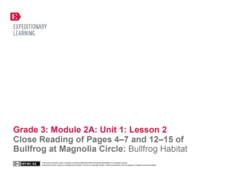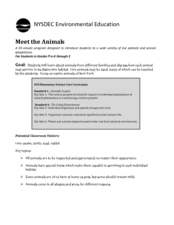EngageNY
Science Talk: How do Bullfrogs Survive
Following the reading of the book Bullfrog at Magnolia Circle, the ninth lesson plan in this unit involves emerging experts in a science talk about how bullfrogs survive. Looking back through the text, young scholars prepare for the...
Roy Rosenzweig Center for History and New Media
Yankee Doodle: How Has It Changed over Time?
Grab your feathers and your hat! And perhaps some macaroni! It's time to investigate the evolution of "Yankee Doodle Dandy." Groups do a close reading of sheet music covers, lyrics, and even YouTube videos to see how this political song...
Curated OER
Adapting to those strange American ways!
High schoolers edit video tapes of two German immigrants according to the slant: How did you adapt to the strange American ways after immigrating to the Omaha area? Students work in groups to name ten problems immigrants might encounter...
ARKive
Penguin Diversity – Mask Making
Penguins are very diverse and well-adapted birds; they live on islands, in warm and cold climates. Little ones examine penguin diversity and discuss the highly functional adaptive traits that have helped them survive in some of the...
EngageNY
Close Reading of Pages 4 - 7 and 12 - 15 of Bullfrog at Magnolia Circle: Bullfrog Circle
Scholars take part in a close reading of pages four through seven and 12-15 of the book, Bullfrog at Magnolia Circle: Bullfrog Circle by Deborah Dennard. Readers identify the story's main idea, list its key details, and examine...
Simon & Schuster
Les Miserables Classroom Activities
Modern readers apply classic themes to Victor Hugo's masterpiece, Les Miserables. After they discuss tricky vocabulary and plot elements from the novel, class members compare Hugo's written work to a stage or film adaptation of the musical.
EngageNY
Grade 10 ELA Module 4, Unit 2, Lesson 25
How do film adaptations differ from their literary counterparts? Scholars watch and analyze the 2011 Royal Shakespeare Company (RSC) production of Shakespeare's Macbeth. Pupils complete a Quick Write analyzing how the RSC production...
EngageNY
Grade 10 ELA Module 4, Unit 2, Lesson 26
How do directors' choices emphasize different elements of a drama? Scholars participate in a discussion about the Royal Shakespeare Company production of Macbeth and Akira Kurosawa's Throne of Blood. Finally, they write an analysis of...
EngageNY
Grade 10 ELA Module 4, Unit 2, Lesson 24
What might viewers notice about the characters, setting, and cinematic choices in the movie version of a play? Pupils view an excerpt from Throne of Blood, Akira Kurosawa's film adaptation of Shakespeare's Macbeth. To finish the lesson,...
Overcoming Obstacles
Adapting to Change
Peter Pan doesn't want to grow up and doesn't want to change. Many middle schoolers feel the same way. The first lesson in the "Looking to the Future" module underscores the concept that change is a natural part of life and that a...
Curated OER
Design-A-Weed
Pupils create a "super weed" that prospers in teh harsh conditions on plant Weediv. They comprehend how weed adaptations give the plants an advantage over native plants. Students define the term adaptation. They give three examples of...
Curated OER
Scales, Scutes, and Skins
Young scholars identify the various adaptations of reptiles and amphibians. After distinguishing between reptiles and amphibians, students discuss the ways in which their adaptations aid in their survival. They participate in a hands on...
Curated OER
Feeding Frenzy
Learners examine, through experimentation and simulation, how insect mouthparts are adapted for particular food sources, discuss how various animals have adapted to survive, play Feeding Frenzy game, and complete activity sheets.
Curated OER
What Makes A Bird A Bird?
Students identify the characteristics of birds and explain how these characteristics are useful in their survival. They explain how both physical and environmental adaptations help birds survive and reproduce. Students create an...
Curated OER
Scales, Scutes, and Skins
Young scholars identify the various adaptations of reptiles and amphibians. After distinguishing between reptiles and amphibians, students discuss the ways in which their adaptations aid in their survival. They participate in a hands...
Curated OER
Meet the Animals
The class will examine a series of live or stuffed animals in order to learn how different animals survive in distinctive habitats. As they examine each animal, they will be asked a series of critical thinking questions geared at getting...
Floyd County Schools
Who Is Hibernating?
Young scientists explore the wintertime behavior of common animals with this presentation on hibernation. Offering clear explanations about the who, what, where, when, and why regarding hibernation, this resource is perfect for primary...
Curated OER
Invent a Plant
Young scholars investigate plant adaptations. In this plant adaptations instructional activity, students create a model of a plant. Young scholars are given action cards detailing specific environmental situations. Students design their...
Curated OER
Food Grab
Students analyze animal adaptations. In this animal adaptation lesson, students create food-gathering devices. Students design devices that would protect animals or plants from predators.
Curated OER
Lesson 9: Adapt to Change
Students examine ways to adapt to changes at job training sites and/or workplace, identify examples of how job descriptions may change, and discuss what to do if asked to make change in schedule or responsibilities at job.
Safe Routes to School
Pollution & Evolution
Bring together a study of two major scientific topics with a lesson on the relationship between pollution and evolution. With the help of a PowerPoint presentation, hands-on activity. and class demonstration young scientists learn how...
Curated OER
Desert Animal Sorting
What makes certain animals better suited for desert life than others? Explore the differences between desert and non-desert animals with this picture sorting activity. Be sure to print the worksheet in color so students can observe and...
Curated OER
Digging up the Dirt on Soil Microbes
Students are introduced to the idea of soil as a habitat for many different organisms. They are introduced to the links between the biological adaptations of an organism and the physical demands of its habitat. Pupils are introduced to...
Curated OER
Diversity And Adaptations Of Organisms
Seventh graders demonstrate the processes of science by posing questions and investigating phenomena through language, methods and instruments of science. They study the body features or systems of several animals.
Other popular searches
- Animal Adaptations
- Adaptive Physical Education
- Ocean Animal Adaptations
- Bird Beak Adaptation
- Adaptive Radiation
- Plant Adaptations
- Behavioral Adaptations
- Adaptation and Evolution
- Bird Adaptations
- Insect Adaptations
- Adaptive Lesson
- Plant and Animal Adaptation

























